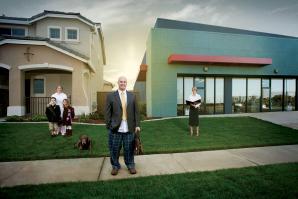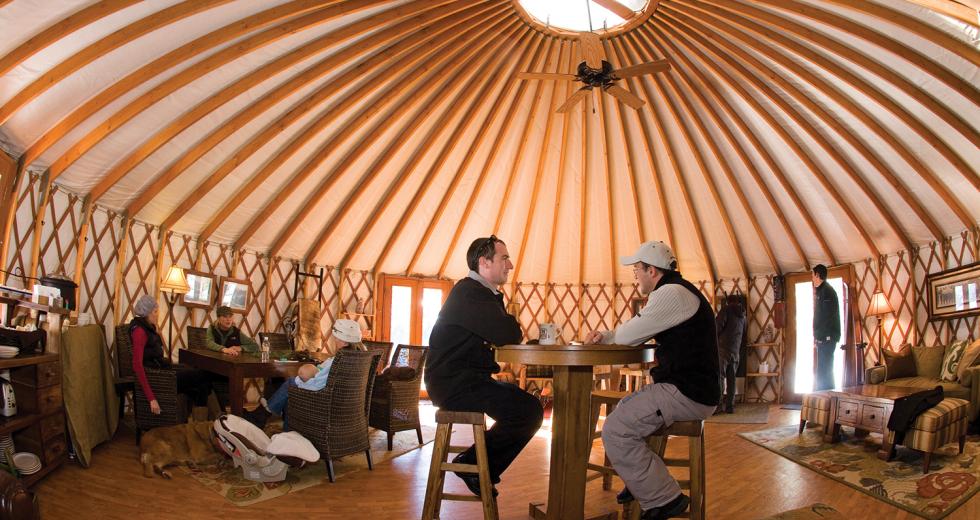Five years ago, Truckee’s Martis Camp fell out of the hands of land planners and golf-course designers and into the hands of lawyers. The 2,177-acre property, slated for 726 homes and two golf courses, was at the center of a controversial battle about the future of the Martis Valley, and neither developers nor conservationists were budging.
Martis Valley’s 45,000 acres are mostly filled with sagebrush and ponderosa pines. The valley’s scenic creeks are considered critical to the area’s fragile ecosystem, particularly since the population of neighboring Truckee has ballooned during the past 20 years, resulting in damage and contamination of local wetlands, meadows and waterways. For many locals, any development with the potential of further ecological damage is concerning.
To complicate things, the lawsuit against Martis Camp and its visionaries, DMB/Highlands Group LLC, wasn’t the only one hindering the luxury home development from breaking ground. Another lawsuit targeting Placer County’s recently enacted Martis Valley Community Plan created a legal quagmire that looked like it might stall the project indefinitely.
But recently, the exclusive gated development that was once so controversial began selling lots and funding conservation projects at the same time. Multimillion-dollar homes are being erected alongside a golf course designed by renowned course architect Tom Fazio. The project has established private lift access to Northstar-at-Tahoe ski resort, and homeowners can fish at a private lake, view movies at a private movie theater and knock down pins at a private bowling lane.
The story of how Martis Camp turned from headlining a publicity-grabbing land battle to successfully selling and developing one of the most exclusive addresses in the region is a tale of compromise. The end result is having an economic effect in an area where building and home buying has lurched to a standstill.
Martis Camp developer DMB/Highlands Group is no stranger to North Tahoe. Before purchasing the Martis Camp property, the developer had already built neighboring Lahontan, a gated, large-lot golf course enclave similar to Martis Camp.
Ron Parr, a partner with DMB/Highlands Group responsible for entitlements and regulatory permits, says the company’s history and understanding of the region helped Martis Camp prosper.
“What we learned from all of the work we did for Lahontan was the groundwork for Martis Camp,” Parr says.
Lahontan was approved by Placer County in 1994, and by the time DMB/Highlands bought the 2,177 acres next door and began planning Martis Camp, they were already expanding Lahontan into a neighboring parcel.
The company is also a veteran at developing luxury recreation property. While some companies saw the real estate boom as an opportunity to jump into a lucrative development market, DMB Associates had been in the business since 1984.
“In very good economic times, you find people developing projects on the success of others. People say, ‘That looks easy. I’ll go do that,’” Parr says. “But in challenging economic times, the well-timed, well-financed, well-thought-out, well-designed projects (that are) appropriately priced succeed.”
DMB Associates had already completed numerous projects in Arizona, Hawaii, Utah and California. The developers teamed with Highlands Management Group, a company with experience in managing golf properties, to form the Martis Camp team, and in 1999, the company picked up the property.
Controversy over development in Martis Valley had been brewing for years. As the real estate market surged, it seemed every property owner in the valley began hatching building plans. Timber giant Sierra Pacific Industries was floating a plan for a ski resort across the valley from Northstar; the Pritzker family, one of the nation’s wealthiest clans and owners of the Hyatt hotel chain, was exploring options for nearly 1,500 acres. Northstar advanced plans for its village and a Ritz-Carlton, Timilick proposed a golf community near Lahontan, and DMB/Highlands pushed forward its plans for both Martis Camp and neighboring Hopkins Ranch.
Soon, Truckee and North Lake Tahoe residents who treasured the bucolic nature of the open, sage-filled valley began to worry about the magnitude of development proposed for the popular dog walking and hiking area. Meanwhile, Placer County began updating an overarching plan that would govern growth in the valley, and suddenly the sum total of all the new building proposals were laid on paper for all to see.
Several environmental groups that had been monitoring the Martis Camp project began arming themselves for a long and tenacious land battle. Local groups, such as the Mountain Area Preservation Foundation and Sierra Watch, were joined by the Sierra Club, the Planning and Conservation League and other big-name national environmental groups in criticizing and opposing plans and projects.
“In challenging economic times, the well-timed, well-financed, well-thought-out, well-designed projects (that are) appropriately priced succeed.”
Ron Parr, partner, DMB/Highlands Group LLC
It wasn’t long before lawsuits began piling up, and the Martis Valley controversy went from a matter debated in public meetings to a battle between attorneys and, eventually, judges.
The Martis Camp project that emerged from intense legal negotiations was quite different than the one proposed. The number of lots dropped from 726 to 653. Hopkins Ranch, proposed as a neighboring golf course community, disappeared altogether and was replaced with a plan for affordable housing. Martis Camp dropped plans for a second par-three golf course, but the heart of the project remained the same — a luxury, recreation-driven, exclusive community between Truckee and Lake Tahoe. When the developer added a private ski connection to Northstar-at-Tahoe, the development went from a summer golf community to a year-round haven.
“People are finding this is totally unique, not just in the area, but in the Western U.S.,” says Brian Hull, the project’s director of sales.
And the development’s economic impact is going well beyond the community’s gatehouse. During legal negotiations, a transfer fee on each parcel sold at Martis Camp was negotiated — a funding source that will generate $72 million in the next 25 years, according to John Eaton, president of the Mountain Area Preservation Foundation. The money will go toward land preservation in the valley, environmental restoration work and community benefit.
“It will generate jobs,” he says.
Although negotiations were at times tense, the two sides say they recognize the value of the compromise. Martis Camp employs up to 62 people during peak golf season and is currently putting contractors to work, pumping money into construction material retailers’ coffers and boosting local environmental restoration efforts and land preservation.
“Our mission is not to vilify development, it is to build a sustainable community in harmony with nature,” Eaton says. “Paradoxically, I think we’re increasing property values because the proximity of open space increases property values.”
Since the summer of 2004, much has changed. The development and building industries are in tatters from the recession, and fears over development in the Martis Valley have waned along with the momentum of the real estate market. But Martis Camp has been selling, with $200 million in home sites sold so far.
“We have sold approximately 240 lots in what I would think anyone would characterize as challenging economic times,” Parr says.
The project has been well capitalized, and the completion of most of the amenities in the site are a testament to DMB/Highlands strong financial backing.
“When prospective homeowners see the completed family barn, the golf course, amphitheater, library and ski connection in place, the sales come easier,” Hull says.
A 50,000-square-foot clubhouse should be completed by 2012. “We feel fortunate to be so well capitalized to be able to deliver these amenities,” Hull says.
While nearly 80 percent of the project’s homeowners have come from San Francisco and Southern California, Martis Camp is also selling across the nation. With the Truckee Tahoe Airport virtually across the street, the project is able to tap into a national clientele that can fly in and out of their vacation homes.
Hull says that as the economy has stabilized, more homeowners have had the confidence to invest in Martis Camp.
“For our buyer base, it is not an affordability question; it’s confidence,” Hull says.
Recommended For You

Growing up Urban
The political climate of land-use planning
For decades, devising a clear solution for California’s suburban sprawl and ensuing car culture has been the Holy Grail for smart-growth advocates. One trip on any of the Golden State’s perpetually clogged roadways during peak hours shows how ineffective most of those efforts have been.

Day on the Green
The political fate of climate-change legislation
For years, the debate over climate change centered almost exclusively on science: Is global warming occurring, and if so, are humans causing it? But with the economy still struggling, the argument has shifted to one of dollars and cents.



